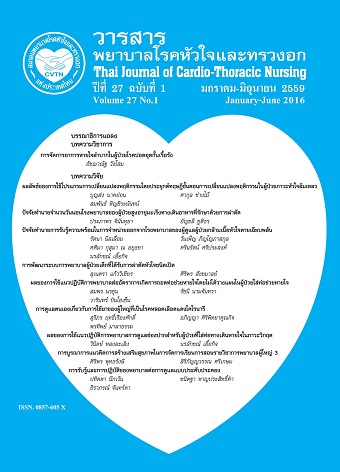การจัดการอาการหายใจลำบากในผู้ป่วยโรคปอดอุดกั้นเรื้อรัง
Keywords:
อาการหายใจลำบาก, โรคปอดอุดกั้นเรื้อรัง, การจัดการอาการ, dyspnea, chronic obstructive pulmonary disease, symptom managementAbstract
อาการหายใจลำบากเป็นการรับรู้ของผู้ป่วยต่อความยากลำบากในการหายใจและรู้สึกต้องออกแรงในการหายใจมากขึ้น อาการหายใจลำบากพบบ่อยในผู้ป่วยโรคปอดอุดกั้นเรื้อรัง (COPD) ส่งผลกระทบให้ผู้ป่วยมีความสามารถในการทำกิจกรรมลดลง วิตกกังวล แยกตัวออกจากสังคม รู้สึกทุกข์ทรมานและคุณภาพชีวิตลดลง บทบาทของพยาบาลเพื่อการจัดการอาการหายใจลำบากในผู้ป่วยโรคปอดอุดกั้นเรื้อรังควรครอบคลุมการบรรเทาอาการและการป้องกันการเกิดอาการ บทความนี้ใช้การจัดการอาการ (Symptom Management Model; SMM) เป็นกรอบแนวคิดเพื่อศึกษาและเข้าใจประสบการณ์การมีอาการหายใจลำบากของผู้ป่วย COPD เพื่อช่วยเหลือผู้ป่วย COPD ให้สามารถจัดการอาการอย่างมีประสิทธิภาพ การจัดการกับอาการหายใจลำบากและการติดตามผลลัพธ์ของการจัดการอาการ แบ่งเป็น 2 ระยะ ได้แก่ ระยะอาการกำเริบเฉียบพลันและระยะฟื้นฟูสภาพ เพื่อบรรเทาการเกิดอาการและป้องกันการเกิดอาการหายใจลำบาก ฟื้นฟูสมรรถภาพปอด และสมรรถภาพทางร่างกาย รวมทั้งส่งเสริมความผาสุกด้านจิตสังคม เพื่อเพิ่มคุณภาพชีวิตของผู้ป่วยโรคปอดอุดกั้นเรื้อรัง
Dyspnea management in patients with chronic obstructive pulmonary disease
Dyspnea is the patient’s perception of an increase in difficulty and labored breathing. Dyspnea is a common symptom in patients with Chronic Obstructive Pulmonary Disease (COPD) that affect the physical disability, anxiety, social isolation, persistent distress and decrease in health-related quality of life. Nurses’ roles of dyspnea management in patients with COPD include reduction and prevention of the symptoms. This article applied the Symptom Management Model (SMM) as a framework to investigate and to understand the patients with COPD’s symptom experiences and enhance them to have effective management of dyspnea. Dyspnea management and outcomes evaluation consists of two phases: acute exacerbation phase and rehabilitation phase. The outcomes of dyspnea management are reduction and prevention of the symptom, rehabilitation of pulmonary and physical ability, as well as promoting psychosocial well-being to enhance their quality of life.
Downloads
How to Cite
Issue
Section
License
บทความนี้ยังไม่เคยตีพิมพ์หรืออยู่ในระหว่างส่งไปตีพิมพ์ในวารสารอื่น ๆ มาก่อน และกองบรรณาธิการขอสงวนสิทธิ์ในการตรวจทาน และแก้ไขต้นฉบับตามเกณฑ์ของวารสาร ในกรณีที่เรื่องของท่านได้ได้รับการตีพิมพ์ในวารสารฉบับนี้ถือว่าเป็น ลิขสิทธิ์ของวารสารพยาบาลโรคหัวใจและทรวงอก






